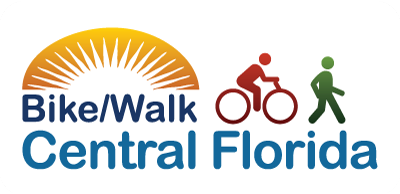
Image from Florida Bicycle Association: FDOT District 1 Secretary Billy Hattaway (Left) and State Bike/Ped Coordinator DeWayne Carver (Right) with FBA Polar water bottles in hand.
You’re riding your bike in the bike lane on a busy street and notice that there is a huge pothole in your way. When traffic is already whizzing by right beside you, where do you go? Wider bike lanes = more room for people on bikes to maneuver on hazardous paths.
DeWayne Carver, 46, is the bicycle and pedestrian coordinator for the Florida Department of Transportation. Carver talked to Orlando Sentinel transportation reporter Dan Tracy about the state’s decision to narrow traffic lanes on state-run roads to make more room for bike lanes.
The state decided earlier this year that it would make car lanes narrower and bike lanes wider. Tell me about it.
The standard width of a lane is 12 feet on an arterial road. We are going to change that down to 11 feet for a couple of reasons. These are for roads that are designed for speeds of 45 mph or less. A narrower lane width it was thought would probably contribute to better speed management. In addition, we were looking for ways to make the bicycle lanes wider (from 4 to 7 foot) because we felt that would be a good counter measure based on research we had done. We were able to come up with a situation where you can narrow the travel lane and widen the bike lane and not increase the cost of the project because you are not having to buy additional right of way.
Define an arterial road.
It’s going to be a larger road and its purpose is really to get people from one place to another in a fairly timely fashion. The lowest level of road you are probably familiar with is a local street. You probably live on a local street. It’s going to be very small, very low speed limits. Your kids can play ball on it. Then you get out to a collector street. That’s the road that gets you out to a bigger road and that’s the arterial road. Most of the roads in the state system are arterial roads. Your larger four, six lane roads. They are designed to move quite a bit of traffic.
Cyclists prefer low-traffic roads. Arterial roads are not low traffic.
They are designed to carry as much traffic as they can. In some cities, especially in Florida, that were built up after World War II, we are using arterial roads in ways that not really were intended. The original idea was you could use local roads to get to local destinations. But in Florida, we’ve developed neighborhoods in such a way with cul de sacs and such that arterial roads serve the local road function. What this means for cyclists is that if you want to get to almost any location you have to get on an arterial road because those are the only roads that go anywhere.
What are the benefits of 7-foot bike lanes over 4-foot lanes?
Four foot is the minimum operating space. That’s just barely enough room for the cyclist to ride along straight. If I throw any kind of obstacle in there, if there’s debris, if there’s a pothole, then the cyclist really has nowhere to go except riding out into traffic. You’re setting up a potential for a crash. By making the bike lane wider you offer the cyclist room to maneuver around obstacles, you give them better site lines.
When you repave a road or build a new road, you will see these changes?
For any new road that is constructed these are the new standards. On existing roads, whenever they get resurfaced, you can get these changes at any time. In southern parts of the state you already have these (11-foot lanes). They just weren’t the standards then. So you may not be able to get the extra space for bike lanes.
How often are roads resurfaced?
In general, the design life is 20 years, but it may not go 20 years before it is resurfaced. It may be more or less than that.
Are you a biker rider? Do you use bike lanes?
Yes. It depends on the bike lane. I’m also a bike instructor. One of the things we teach people in classes is not to let the paint think for you. You need to make smart traffic decisions. If I look ahead and see they’ve left the trash cans out in the bike lane again then I am going to get out of the bike lane and I’m going to ride in the traffic lane until I get around that obstacle. Ideally, cyclists will be able to stay in the 7-foot bike lanes more of the time, because we’ve addressed many of the reasons for leaving a narrower bike lane.
[email protected] or 407-420-5444.

